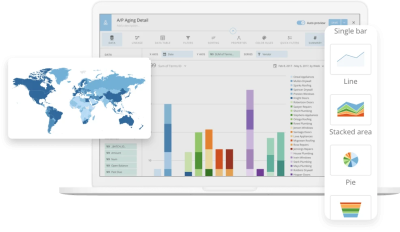A guide to building customer personas with business intelligence
Consumers can be mysterious. This can be frustrating when it comes to finding a successful marketing strategy.
You would think that in the era of big data, we would have a pretty good understanding of who our customers are, what they want, and how to best serve them. But the fact is, most businesses still know very little about their customers.
Customers’ whims and needs change on a dime. And as new competitors enter the market, it can be hard to keep up.
If your company is operating without actionable customer insights, you’re not alone. Most firms fail to offer a succinct and accurate description of their target customer.
The good news is that there’s a way to get a better handle on your customer base by creating customer personas.
A persona is a fabricated character that represents a segment of your customer base. By creating personas, businesses can get a better understanding of who their customers are, what they want, and how they can best serve them.
This process can be improved by using business intelligence tools and techniques to create more accurate and detailed personas. When you understand your customer base, you can make better decisions about where to focus your marketing efforts and how to best meet their needs.
Creating a customer persona is not an exact science, but there are some tried-and-true methods you can use to get started using business intelligence. In this article, we will break down the persona creation process and show you how to use business intelligence to create accurate, actionable customer personas.

What is a customer persona?
A customer persona is a semi-fictional representation of a segment of your customer base. Personas are based on real data about your customers, but they also include some fictional elements to make them more relatable and easier to understand.
For example, let’s say you own a women’s clothing store. You might create a persona for your target customer:
- Name: Sarah
- Age: 25-34
- Location: New York City
- Income: $50,000-$75,000
- Occupation: Marketing professional
- Interests: Fashion, travel, fitness
- “Sarah is a 25-34-year-old marketing professional from New York City. She has a college degree and earns a salary of $50,000-$75,000. Sarah is interested in fashion, travel, and fitness. She likes to keep up with the latest trends and is always looking for new brands to try.”
As you can see, this persona includes both real data (Sarah’s age, location, and income) and fictional elements (her occupation and interests). It omits unnecessary details (Sarah’s last name, for example) that would make the persona less relatable.
Personas are not meant to be exhaustive representations of your customer base. Rather, they are meant to be simplified models that you can use to better understand your customers.
You probably already have most of the data you need to create a persona. The key is to know where to look and how to use that data to create a realistic and relatable character.
Why create a customer persona?
If you’re still not convinced that creating a customer persona is worth your time, consider the benefits:
1. Improved customer understanding: By creating a customer persona, you will gain a better understanding of who your customers are, what they want, and the type of communication they prefer.
2. Better decision-making: With a clear understanding of your customer base, you can make more informed decisions about where to focus your marketing efforts and how to best serve your customers.
3. Increased sales and revenue: When you understand your customers better, you can create more targeted marketing campaigns that are more likely to result in sales.
4. Improved customer satisfaction: By creating personas, you can ensure that your products and services are designed with your target customer in mind, leading to improved satisfaction and loyalty.
5. Reduced costs: Creating personas can help you avoid wasting marketing spend on campaigns that are not targeted to your most valuable customers.
How to create a customer persona with business intelligence
There are a number of different types of business intelligence data that you can use to create a customer persona. Some common examples include:
Demographic data: This is information about your customer’s age, gender, location, income, education level, etc.
Psychographic data: This is information about your customer’s lifestyle, values, interests, and personality.
Behavioral data: This is information about your customer’s purchasing behaviors, such as what they buy, when they buy it, and how much they spend.
You can collect this data in a number of ways:
Surveys: You can use surveys to collect data about your customers’ demographics, psychographics, and behaviors.
Customer interviews: You can conduct one-on-one or group interviews with your customers to learn more about them.
Focus groups: You can gather a group of customers together to discuss your products or services.
Secondary research: You can use data that has already been collected by other sources, such as government agencies or market research firms.
Once you have collected the data, you will need to analyze it to identify trends and patterns. This will help you create a more detailed persona that is accurate and relatable.
There are a number of different business intelligence tools you can use to analyze your data, including data visualization tools, statistical analysis tools, and text analysis tools. Some BI solutions offer all of these tools as part of their products.

A guide to building customer personas with business intelligence
Now that you know why creating customer personas is important and how to collect and analyze the data you need, it’s time to put all of the pieces together. Follow these steps to create a customer persona for your business:
1. Define your goals for your persona
No data is worthwhile if it isn’t going to help you achieve your goals. Before you even start collecting data, take some time to define what you want to use your persona for. This will help you determine the right data to collect and how to best use it.
Ask questions such as:
- How will I collect this data with business intelligence?
- What do I want to use it for within my organization?
- Which departments or teams will be using this persona?
- How will this persona be implemented across my different business operations?
2. Choose the right data sources
Once you know what kind of data you need, it’s time to choose the right sources. If you’re looking for demographic data, government agencies or market research firms are good sources. If you’re looking for psychographic data, customer surveys are a good option. And if you’re looking for behavioral data, customer interviews or focus groups can be helpful.
Make sure that your data sources align with your goals for the persona. There’s no point in collecting data that you’re not going to use.
3. Collect and clean your data
Now it’s time to start collecting data. This is where business intelligence comes into play. Use the tools and methods you’ve chosen to collect the right data for your persona.
Once you have all of your data, it’s important to clean it up before you start analyzing it. This includes removing duplicates, filling in missing values, and coding categorical variables, all made easy with the right BI tool.
4. Analyze your data
Once you have cleaned up your data, it’s time to start analyzing it. Business intelligence tools can take your data and turn it into insights that will help you create your persona. From dashboards to statistical analyses, these tools can help you understand your data and find trends and patterns that provide insight into consumer behavior.
5. Create your persona
Now that you have all of the pieces, it’s time to put them together to create your persona.
Step 1: Give your persona a name
Step 2: Create a demographic profile
Include information such as age, gender, income, education, and family status.
Step 3: Outline your persona’s psychographic profile
Include information such as their values, attitudes, and lifestyle.
Step 4: Describe your persona’s behavior
Include information such as how they make decisions, what motivates them, and what their buying patterns are.
Step 5: Add a picture
Find a picture that represents your persona and add it to the profile. This will help you visualize who they are and what they look like — a great way to bring your persona to life.
Step 6: Write a biography
Include information such as their backstory, their day-to-day life, and their hopes and dreams. This will help you understand how they think and what motivates them.
The bottom line
Building customer personas with business intelligence is a powerful way to improve your data-driven decision-making. By better understanding your customers, you can make more informed decisions about where to focus your efforts and how to best serve their needs.
With the right data and the right tools, you can create a customer persona that will help you take your business to the next level. Make sure to check out the available business intelligence tools that can help you create and effectively use your persona.
Check out some related resources:

Guide to Data Pipeline Design: Steps and Patterns

8 Best AI Tools for Data Visualization






